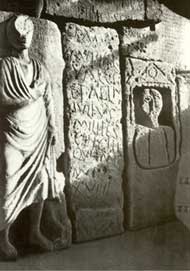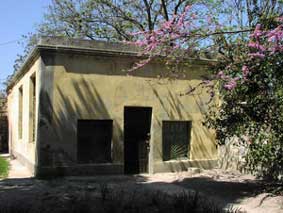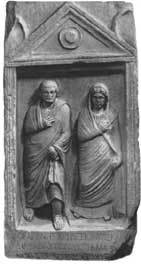
The collection of epigraphy from Chersonesos contains about 600 monuments. The first inscriptions of Chersonesos were discovered in the 18th century, when some architectural details and fragments of tombstones were discovered amidst the ancient city ruins and then used for house building in the new city of Sevastopol. It was 1793, when the tombstone for Theagenes and his wife Oulpia was uncovered; the statue base of Agasikles was found in the next year.
 Inscriptions in the old museum |
By the middle of the 19th century, the number of the inscriptions increased not only because of chance finds, but also in result of the excavations, which started in Chersonesos. The greatest number of epigraphic monuments was supplied by the excavations organized in Chersonesos by the Imperial Archaeological Commission annually from 1888 to 1915. The head of this work, K. K. Kostsyushko-Valyuzhinich, established a small museum with a lapidarium, that is a storage for inscriptions on stone (from Latin lapis, 'stone'), where he collected architectural details and fragments from buildings, as well as inscriptions dated back to the Classical and Medieval periods. |
After the October revolution in Russia (1917), the museum display was placed to the former monastery building. Besides various archaeological materials, this display possessed about 70 inscriptions, though the others were kept in the museum storage. In the years of the Second World War, almost every compartment of the storage was destroyed, and a part of the exhibits, including some inscriptions, perished.
In the post-war years, museum staff organized and fulfilled a great job of setting the museum storage, the Funds, in order. It was 1957 when the storage compartment for inscriptions was renovated and equipped. The Museum was working on the establishment of this lapidarium as a scholarly collection of epigraphic monuments in cooperation with the Ancient and Medieval Archaeology Department of the Institute of Archaeology of the Academy of Sciences of Ukrainian SSR. This task was started on the initiative, under supervision, and with immediate participation of the Doctor of Science in history, professor and well-known epigraphist Ella Isaakovna Solomonik. The head of the storage department of the Museum A. M. Gilevich and graduate students of Classics departments of Leningrad and Lvov universities also participated in the project.
Chronological method was laid as a foundation of the monuments location within the lapidarium, and within every chronological group, the monuments of similar significance are combined together: decrees, tombstones, dedications, etc. Latin inscriptions are made into separate cluster within the largest group of monuments dating to the Roman period. Such a location seems to be the most expedient and convenient for both viewing the lapidarium and further investigation of epigraphical monuments from Chersonesos. It allows one to see the total number of inscriptions that survived, from various periods, types of stone treatment, and to make comprehensive, comparative research of paleographic and other features of inscriptions dating to this or that period, as ell as general trend in the development of script from the 4th century B. C. to the late Middle Ages.
Our Preserve finds a great advantage of its collection in the completeness of its epigraphic materials. It possesses the overwhelming majority of inscriptions discovered in Chersonesos; only very few of them are in the museums of Moscow, St. Petersburg, and Odessa.
The preserve's epigraphic collection reflects every principle period of Chersonesos history. Slabs with inscriptions of most interesting contents are displayed in expositions of ancient and medieval departments of the museum: civic oath of Chersonesos; decree honoring local historian Syriskos; proxenies (that is giving some rights to foreigners) for citizens of Herakleia Pontika and Sinope; a treaty with Pharnakes, the king of Pontos; correspondence with the governor of Roman Moesia; list of those who won sport competitions; decree honoring Aristonos; inscription honoring the emperor Zeno; and a group of tombstones, which date to the Roman period and bear Greek or Roman inscriptions and portraits of the dead.
The earliest epigraphic monuments of Chersonesos date to the 4th and 3rd centuries B. C. Artifacts of the Hellenistic period make the largest and most different in its contents part of the collection. A small section of the lapidarium presents the group of Roman and medieval inscriptions.
Recent years excavations and chance finds supplied the preserve's collection with new interesting monuments, but, misfortunately, the premise that has been housing the collection since 1957 is crying for reconstruction for ages.

Epigraphic lapidarium
